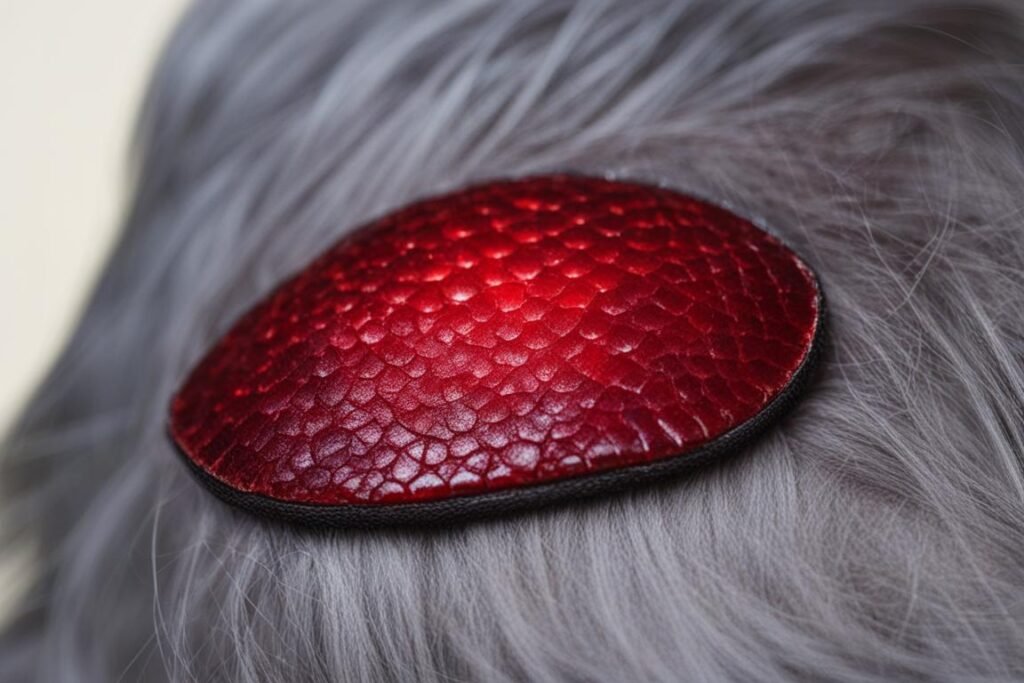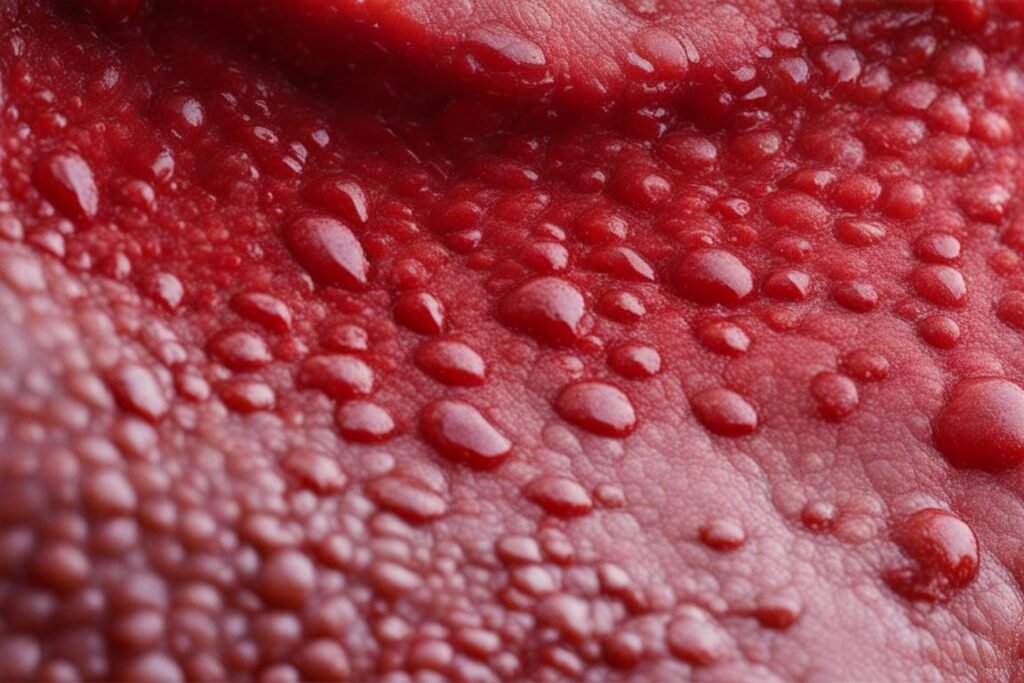AIDS Skin Lesions: Many people with HIV experience skin lesions due to the impact of the virus on the immune system. HIV weakens the immune system, making individuals more susceptible to various skin infections and conditions, including fungal, viral, and bacterial infections, as well as certain types of skin cancers. Skin lesions can result from opportunistic infections, other illnesses associated with HIV, or side effects of HIV medications. Around 1.2 million people in the United States are living with HIV, and dermatological conditions are common among this population.
Living with HIV infection can present unique challenges, including the management of skin conditions. In this article, we will explore common skin conditions in people with HIV, discuss the types of skin cancers they may be prone to, and provide tips for prevention and care. We will also emphasize the importance of antiretroviral therapy in supporting the immune system and share resources and support for those seeking assistance in managing their skin lesions.
Key Takeaways:
- AIDS weakens the immune system, making individuals more susceptible to skin infections and conditions.
- Common skin conditions in people with HIV include seborrheic dermatitis, folliculitis, and herpes simplex.
- Kaposi sarcoma is a type of skin cancer that often occurs in individuals with advanced HIV infection.
- Effective HIV treatment, including antiretroviral therapy, is crucial in managing and preventing skin lesions.
- Seeking medical care, practicing good hygiene, and taking preventive measures are essential in managing skin lesions in people with HIV.
In the following sections, we will delve deeper into each aspect and provide comprehensive information to help those with HIV manage their skin condition with confidence.
Common Skin Conditions in People with HIV
People with HIV commonly experience various skin conditions as a result of their weakened immune system. These conditions can range from mild to severe and may include:
- Seborrheic dermatitis: This scaly and itchy skin condition affects the hairline and nasolabial folds. It is characterized by redness, flaking, and greasy skin.
- Folliculitis: Inflammation of the hair follicles is prevalent among HIV patients, especially those with low CD4 counts. It can cause small, red bumps and may be itchy or painful.
- Herpes simplex: HIV-positive individuals are more susceptible to herpes simplex virus infections, which can cause cold sores or fever blisters around the mouth and painful ulcers in the genital or anal area.
- Human papillomavirus (HPV): HPV can cause warts, including genital warts, in people with HIV.
- Molluscum contagiosum: This highly contagious viral infection results in flesh-colored bumps on the skin. It commonly affects HIV-positive individuals, and the bumps can appear in clusters.
Managing these skin conditions requires proper medical attention and adherence to treatment recommendations. It is important for individuals with HIV to consult with a healthcare professional, such as a dermatologist, who can provide accurate diagnosis and develop an appropriate treatment plan.
Seborrheic Dermatitis
Seborrheic dermatitis is a chronic inflammatory skin condition that primarily affects areas rich in sebaceous glands, such as the scalp, face, and upper chest. It is characterized by redness, flaking, and greasy skin. The exact cause of seborrheic dermatitis is unknown, but it is thought to be linked to a combination of genetic, environmental, and immune factors.
Folliculitis
Folliculitis is the inflammation of one or more hair follicles, leading to small red bumps or pustules on the skin. It is commonly caused by bacteria, fungi, or viruses entering the follicles. People with HIV, especially those with low CD4 counts, are more prone to folliculitis due to their weakened immune system.
Herpes Simplex
Herpes simplex virus infections can cause cold sores or fever blisters, typically around the mouth area. In individuals with HIV, herpes simplex can also lead to painful ulcers in the genital or anal area. These infections can be recurrent and require antiviral medications for management.
Human Papillomavirus (HPV)
Human papillomavirus (HPV) infections can cause various types of warts, including genital warts, in people with HIV. These warts can be sexually transmitted and may require specific treatments, such as topical creams, cryotherapy, or surgical removal.
Molluscum Contagiosum
Molluscum contagiosum is a viral skin infection characterized by flesh-colored bumps with a central dimple. These bumps can appear in clusters and are highly contagious. HIV-positive individuals may experience more severe and persistent cases of molluscum contagiosum, requiring treatment options such as cryotherapy or topical medications.
It is essential for individuals with HIV to maintain regular medical check-ups to monitor their skin health and address any skin conditions promptly. Early intervention and appropriate treatment can help manage these common skin conditions and improve overall well-being.
Kaposi Sarcoma: A Type of Skin Cancer
Kaposi sarcoma is a type of skin cancer that often develops in individuals with advanced HIV infection and a low CD4 cell count. This rare form of cancer causes dark skin lesions, which can appear as patches or nodules ranging in color from brown to purple or red. In addition to affecting the skin, Kaposi sarcoma can also spread to other organs such as the lungs and liver, potentially leading to life-threatening complications.
The development of Kaposi sarcoma is closely associated with advanced HIV infection and a weakened immune system. People with a low CD4 cell count are particularly susceptible to this type of skin cancer. CD4 cells, also known as T cells, play a crucial role in maintaining a strong immune system. When HIV destroys these cells, the body becomes more vulnerable to opportunistic infections and the development of diseases like Kaposi sarcoma.
Managing Kaposi sarcoma involves a combination of treatments tailored to the individual’s condition. Antiretroviral therapy, the cornerstone of HIV treatment, is essential in controlling the progression of both HIV infection and Kaposi sarcoma. This therapy helps boost the immune system and reduce the risk of complications. Other treatment options for Kaposi sarcoma include local therapy, such as radiation or surgery, and chemotherapy for more advanced cases.
In advanced stages of HIV infection, Kaposi sarcoma can be a challenging condition to manage. The prognosis depends on various factors, including the extent of the cancer and the overall health of the individual. However, with early detection, timely treatment, and effective HIV management, the outlook for individuals with Kaposi sarcoma can be improved.
Key Points:
- Kaposi sarcoma is a type of skin cancer associated with advanced HIV infection and a low CD4 cell count.
- The cancer manifests as dark skin lesions in shades of brown, purple, or red.
- Antiretroviral therapy, along with other treatment options, is used to manage Kaposi sarcoma.
- Early detection and effective HIV management are crucial for improving the prognosis of Kaposi sarcoma.
Oral Hairy Leukoplakia and Thrush: Oral Infections

In addition to skin conditions, individuals with HIV may also experience oral infections that affect the mouth and tongue. Two common oral infections in people with HIV are oral hairy leukoplakia and thrush.
Oral Hairy Leukoplakia
Oral hairy leukoplakia is a viral infection that causes white, hairy lesions to develop on the tongue. These lesions cannot be scraped off and may appear wrinkled or corrugated. The condition is caused by the Epstein-Barr virus (EBV) and is more prevalent in individuals with severely weakened immune systems due to HIV/AIDS.
Although oral hairy leukoplakia typically does not cause any pain or discomfort, it can be a sign of advanced HIV infection. The presence of oral hairy leukoplakia may indicate a decline in the immune system function.
Oral hairy leukoplakia does not require specific treatment unless it causes significant symptoms or interferes with eating or speaking. Managing the underlying HIV infection with antiretroviral therapy is often sufficient to control the condition. Regular dental check-ups and good oral hygiene practices, such as brushing the teeth and tongue twice daily, can also help prevent complications.
Thrush
Thrush, or oral candidiasis, is a common fungal infection in individuals with HIV/AIDS. It is characterized by the presence of a thick white layer on the tongue or inner cheeks, which may resemble cottage cheese. The infection can also cause redness, soreness, and discomfort in the mouth.
Thrush occurs when there is an overgrowth of Candida fungus, which is normally present in the mouth, but can multiply under certain conditions such as a weakened immune system. Individuals with low CD4 cell counts are particularly susceptible to thrush.
Thrush can usually be treated with antifungal medications that come in the form of mouth rinses, lozenges, or oral tablets. In severe cases, oral fluconazole, a prescription antifungal, may be recommended. Effective HIV treatment, including antiretroviral therapy, is crucial for controlling thrush and preventing its recurrence.
Preventing Oral Infections
Maintaining a healthy immune system is essential for preventing and managing oral infections in individuals with HIV. Consistent use of HIV medication, such as antiretroviral therapy, is crucial for suppressing the virus and improving immune function. Good oral hygiene practices, regular dental check-ups, and avoiding behaviors that increase the risk of infections, such as smoking, can also help prevent oral infections.
Seeking medical advice from a healthcare professional or dentist specializing in HIV care is important for diagnosing and managing oral infections. They can provide appropriate treatment options and advice on maintaining oral health.
Molluscum Contagiosum: A Highly Contagious Skin Infection

Molluscum contagiosum is a highly contagious viral skin infection that causes flesh-colored bumps on the skin. This condition is particularly prevalent among individuals with HIV/AIDS, who may experience outbreaks of over 100 bumps at a time.
The flesh-colored bumps, known as mollusca, are usually smooth and dome-shaped, with a small dimple in the center. They can appear on various parts of the body, including the face, neck, arms, and genitals.
The transmission of molluscum contagiosum occurs through direct skin-to-skin contact, commonly through sexual contact or sharing personal items such as towels or clothing. Individuals with compromised immune systems, such as those living with HIV, are more prone to this infection.
To manage and prevent the spread of molluscum contagiosum, several treatment options are available. One common method is liquid nitrogen cryotherapy, where the bumps are frozen off using extremely cold temperatures. Other treatments include laser removal or the application of topical ointments.
It’s important to note that effective HIV treatment plays a vital role in managing molluscum contagiosum. By maintaining a healthy immune system through antiretroviral therapy, individuals can minimize the severity and duration of outbreaks and reduce the likelihood of spreading the infection to others.
Psoriasis and Seborrheic Dermatitis: Chronic Skin Conditions

Psoriasis and seborrheic dermatitis are chronic skin conditions that frequently occur in individuals with HIV. These conditions can cause discomfort and affect the quality of life for those experiencing them. Understanding the causes and treatment options for psoriasis and seborrheic dermatitis is crucial for effectively managing these conditions.
Psoriasis
Psoriasis is a chronic skin condition characterized by the rapid buildup of skin cells, resulting in thick, red, and scaly patches. It is caused by an overactive immune system, which mistakenly targets healthy skin cells. While psoriasis can affect anyone, individuals with HIV are more susceptible to this condition due to their compromised immune system. The severity of psoriasis symptoms can vary, ranging from mild to severe.
Psoriasis can appear on different parts of the body, including the scalp, elbows, knees, and lower back. It can also affect the nails, causing pitting or discoloration. Although there is no cure for psoriasis, certain treatments can help manage the symptoms and reduce flare-ups.
| Treatment Options for Psoriasis | Benefits |
|---|---|
| Topical Steroids | Reduces inflammation and itching |
| Retinoid Creams | Controls skin cell growth |
| Phototherapy | Uses UV light to slow down skin cell production |
It is important to note that effective HIV treatment is crucial for managing psoriasis in individuals with HIV. Properly controlling the virus and supporting the immune system can significantly improve psoriasis symptoms and overall skin health.
Seborrheic Dermatitis
Seborrheic dermatitis is a common chronic skin condition characterized by the formation of yellow, oily, and scaly patches on the scalp, face, and other areas with sebaceous glands. The exact cause of seborrheic dermatitis is still not fully understood, but it is believed to be associated with a yeast overgrowth called Malassezia.

Individuals with HIV are more prone to developing seborrheic dermatitis due to their compromised immune system. Stress, cold weather, certain medications, and hormonal changes can also trigger or worsen seborrheic dermatitis symptoms.
Effective management of seborrheic dermatitis involves proper cleansing, moisturizing, and targeted treatment when necessary. Some treatment options include:
- Antifungal shampoos or creams: These products can help control the yeast overgrowth.
- Topical steroids: They help reduce inflammation and itching.
- Calcineurin inhibitors: These medications can be prescribed for more severe cases of seborrheic dermatitis.
Similar to psoriasis, appropriate HIV treatment is essential for effectively managing seborrheic dermatitis in individuals with HIV. By addressing the underlying immune system dysfunction, symptoms of seborrheic dermatitis can be significantly reduced.
Note: It is important to consult with a healthcare professional, such as a dermatologist, for an accurate diagnosis and personalized treatment plan for psoriasis and seborrheic dermatitis.
Other Skin Conditions Related to HIV

Alongside the more common skin conditions discussed, people with HIV may also encounter other related dermatological issues. These conditions include:
- Scabies: Scabies is a highly contagious skin infestation caused by tiny mites burrowing into the upper layer of the skin. Symptoms include intense itching, a pimple-like rash, and the presence of small blisters or sores. Scabies is easily transmitted through close skin-to-skin contact and can spread rapidly, especially in crowded environments.
- Warts: Warts are benign skin growths caused by the human papillomavirus (HPV). Individuals with HIV are more susceptible to developing warts and may experience an increased number and size of warts compared to those without HIV. Warts can appear on various parts of the body and may be flat, raised, or have a cauliflower-like appearance.
- Photodermatitis: Photodermatitis is a condition in which the skin reacts abnormally to sunlight or artificial light sources. Common symptoms include redness, blistering, and itching. People with HIV may be more prone to developing photodermatitis due to the immune system’s compromised state.
- Prurigo Nodularis: Prurigo nodularis is a chronic skin disorder characterized by intensely itchy nodules or bumps. This condition can be especially challenging for individuals living with HIV, as the itching can lead to further skin damage and infections.
Managing these conditions often involves a combination of treatments tailored to each individual’s needs. Treatment options may include antiretroviral therapy to improve immune function, topical medications to alleviate symptoms, cryotherapy to remove warts, and strategies for managing HIV/AIDS-related symptoms.
Summary of Other Skin Conditions Related to HIV
| Skin Condition | Causes | Symptoms | Treatment Options |
|---|---|---|---|
| Scabies | Mites infestation | Intense itching, rash, blisters, sores | Topical medications, antihistamines |
| Warts | Human papillomavirus (HPV) infection | Benign skin growths, various appearance | Cryotherapy, topical treatments, surgical removal |
| Photodermatitis | Abnormal skin reaction to light | Redness, blistering, itching | Avoidance of sunlight, protective clothing, topical corticosteroids |
| Prurigo Nodularis | Unknown, possibly immune-related | Itchy nodules or bumps | Topical corticosteroids, antihistamines, phototherapy |
Importance of Antiretroviral Therapy
Antiretroviral therapy is a critical component of managing HIV/AIDS and plays a vital role in the well-being of individuals living with the virus. This therapy involves the use of medications that help suppress the amount of HIV in the body, allowing the immune system to recover and function more effectively. By reducing the viral load, antiretroviral therapy helps prevent HIV-related complications and supports the overall health and quality of life of those with the infection.
One of the key benefits of antiretroviral therapy is its ability to improve CD4 cell counts. CD4 cells are a type of white blood cell that plays a crucial role in supporting the immune system. HIV specifically targets and attacks CD4 cells, leading to a weakened immune response and increased vulnerability to infections. However, effective use of antiretroviral therapy can significantly increase CD4 cell counts, strengthening the immune system and reducing the risk of opportunistic infections.
By suppressing the replication of HIV, antiretroviral therapy also helps minimize the risk of HIV-related complications, including skin lesions. People with HIV/AIDS are more susceptible to various skin infections and conditions due to the impact of the virus on the immune system. Consistent and effective use of antiretroviral therapy helps maintain healthier skin and reduces the frequency and severity of HIV-related dermatological complications.
In addition to antiretroviral therapy, a healthy lifestyle is essential for supporting the immune system and overall well-being. This includes consuming a balanced diet that provides essential nutrients, engaging in regular physical activity to promote fitness, and ensuring adequate rest and sleep. Adopting these healthy habits alongside antiretroviral therapy can help individuals with HIV/AIDS in managing their condition and enhancing their immune system’s ability to fight off infections and maintain optimal health.
Benefits of Antiretroviral Therapy:
- Suppression of HIV replication in the body
- Improved CD4 cell counts and immune system function
- Reduced risk of HIV-related complications, including skin lesions
- Support for overall health and quality of life
In conclusion, antiretroviral therapy is a crucial component of HIV/AIDS management. By effectively suppressing HIV replication, improving CD4 cell counts, and reducing the risk of complications, it plays a vital role in supporting the immune system and overall well-being. Consistent and proper use of antiretroviral therapy, in combination with a healthy lifestyle, empowers individuals with HIV/AIDS to live healthier lives and effectively manage their condition.
Seeking Medical Care for Skin Lesions
If you notice any skin lesions of unknown cause, it is important to consult with a healthcare professional specializing in HIV or skin conditions.
A dermatologist can perform a physical examination, review your medical history, and may conduct a skin biopsy to determine the cause of the lesions. Early detection and appropriate treatment can help manage and improve skin lesions in people with HIV.
It is crucial to provide the dermatologist with a detailed medical history, including any past or current infections, exposure to irritants or allergens, and relevant medications. This information can assist in establishing a more accurate diagnosis and developing an appropriate treatment plan.
Skin Biopsy: A Diagnostic Procedure
A skin biopsy is a diagnostic procedure where a small sample of tissue is removed from the affected area for examination under a microscope. This procedure helps in determining the cause and nature of skin lesions, offering valuable insights for accurate diagnosis and treatment.
There are different types of skin biopsies, including shave biopsy, punch biopsy, and excisional biopsy, each suited for specific situations and lesion characteristics. The dermatologist will determine the most appropriate technique based on the individual’s specific needs and circumstances.
Early detection and diagnosis through a skin biopsy can lead to timely and targeted treatment, improving the outcomes for individuals with skin lesions.
Importance of Dermatological Care
Collaborating with a dermatologist who specializes in HIV-related skin conditions is essential. These professionals have expertise in diagnosing and managing a wide range of skin disorders associated with HIV, ensuring comprehensive and effective care.
A dermatologist can provide personalized treatment options tailored to the individual’s specific needs, taking into account their overall health, stage of HIV infection, and other contributing factors. They can also offer guidance on managing side effects of HIV medications and recommend preventive measures to protect the skin.
Early Detection and Effective Treatment
Early detection of skin lesions and prompt medical care are crucial for individuals living with HIV. Seeking timely treatment can help prevent complications, manage existing lesions, and improve overall skin health.
Early intervention and appropriate treatment can positively impact the condition and quality of life for individuals with HIV-related skin lesions.
Remember to follow the prescribed treatment plan diligently and communicate any changes or concerns to the dermatologist. Regular follow-up visits can help monitor the progress and adjust the treatment approach if necessary.
Prevention and Outlook
Taking preventive measures is crucial in managing HIV and reducing the occurrence of skin lesions and other complications. One of the most effective preventive measures is the consistent use of antiretroviral therapy (ART). Antiretroviral drugs have been proven to improve the immune system and significantly reduce the risk of opportunistic infections in people with HIV.
By adhering to a prescribed ART regimen, individuals can maintain a good quality of life and minimize the impact of HIV on their overall health. It is important to follow the recommended dosage and frequency of medication to ensure its effectiveness. Additionally, practicing safe behaviors, such as using barrier methods during sexual intercourse, can further reduce the risk of transmission and the development of skin lesions caused by sexually transmitted infections.
In addition to preventive measures and ART, seeking timely medical care for any skin concerns is crucial. Regular check-ups with a healthcare professional experienced in HIV management and skin conditions, such as a dermatologist, can help identify and address any issues early on. Early detection and appropriate treatment can greatly improve the management and outcome of skin lesions in individuals living with HIV.
With advances in HIV treatments, the overall outlook for individuals with HIV has improved significantly. Effective use of antiretroviral drugs, along with comprehensive healthcare and support, has allowed people living with HIV to lead fulfilling lives with a higher quality of life. By following preventive measures, adhering to HIV treatment, and seeking appropriate medical care, individuals can effectively manage their condition and minimize the impact of HIV-related skin lesions on their overall well-being.
Key Points:
- Consistent use of antiretroviral therapy (ART) is essential to prevent skin lesions and other complications in individuals with HIV.
- Practicing safe behaviors, such as using barrier methods during sexual intercourse, further reduces the risk of transmission and development of skin lesions.
- Regular check-ups with healthcare professionals experienced in HIV management and skin conditions can help identify and address skin concerns in a timely manner.
- Effective use of preventive measures, HIV treatment, and seeking medical care can greatly improve the overall outlook and quality of life for individuals living with HIV.
| Preventive Measures | Benefits |
|---|---|
| Consistent use of antiretroviral therapy (ART) | – Improves immune system – Reduces risk of opportunistic infections |
| Practicing safe behaviors | – Reduces risk of transmission – Minimizes development of skin lesions caused by sexually transmitted infections |
| Regular check-ups with healthcare professionals | – Early detection and treatment of skin lesions – Effective management of HIV-related complications |
Resources and Support
For individuals living with HIV who are seeking information and assistance with managing skin lesions, there are various resources and support available. These resources can provide valuable guidance and emotional support throughout their journey. Additionally, dermatology clinics specializing in HIV-related skin conditions can offer specialized care and treatment options.
HIV Support Groups
Support groups play a crucial role in providing a sense of community, empathy, and understanding for individuals with HIV. These groups bring together people who can relate to the challenges and experiences of living with the condition. Sharing experiences and gaining insights from peers can be empowering and help individuals navigate the complexities of managing skin lesions. Online forums and community platforms also provide a safe space for individuals to connect, seek advice, and share knowledge.
HIV/AIDS Organizations
HIV/AIDS organizations are dedicated to raising awareness, providing education, and offering support to individuals living with HIV. These organizations often have helplines, websites, and online resources where individuals can find information about skin lesion management and connect with healthcare professionals who specialize in HIV care. They can provide trusted and up-to-date information on treatments, prevention strategies, and the latest research in the field.
Dermatology Clinics
Dermatology clinics that specialize in HIV-related skin conditions are equipped with the expertise to diagnose and treat various skin lesions. These clinics offer tailored treatment options that consider the unique needs and challenges faced by individuals with HIV. Dermatologists can provide comprehensive evaluations, recommend appropriate treatments, and monitor the progress of skin lesions over time. By collaborating with dermatology clinics, individuals can access the latest advancements in HIV-specific dermatological care.
Conclusion
In conclusion, managing AIDS skin lesions requires comprehensive care and support for individuals living with HIV. The impact lesions on the skin of HIV on the immune system makes them more hiv and aids susceptible to skin infections and conditions. Effective HIV treatment, including antiretroviral common in people therapy, plays a crucial role treat hiv in supporting the immune system skin disease lesions may caused by hiv and preventing complications.
Seeking medical care from professionals specializing in HIV or skin conditions is essential for early diagnosis and appropriate treatment. Maintaining good hygiene practices, such as regular cleansing and moisturizing, can help manage and improve skin lesions. Additionally, following preventive measures, including consistent use of antiretroviral therapy, can reduce the occurrence of skin lesions and other HIV-related complications.
With proper care and support, individuals with HIV can lead healthy lives and effectively manage their skin conditions. The integration of comprehensive HIV care and skin condition management is crucial for overall well-being and quality of life. By addressing the underlying immune system support and following treatment regimens, individuals with HIV can minimize the impact of skin lesions and maintain optimal skin health.
Also Read : Boost Your Glow with Skin Better Vitamin C Today!
FAQs
A: HIV skin lesions are skin changes or conditions that may be more severe in people infected with HIV. These skin manifestations can include dark lesions, rashes, and certain skin problems that are caused by the human immunodeficiency virus.
Q: What are the common skin conditions associated with HIV-infected individuals?
A: Common skin conditions in people with HIV include herpes zoster, oral hairy leukoplakia lesions, and white lesions. These conditions may manifest at later stages of HIV infection and indicate advanced disease.
Q: How are HIV skin lesions diagnosed?
A: Diagnosis of HIV skin lesions involves examining the skin changes and considering the individual’s HIV status. Certain skin manifestations are indicative of human immunodeficiency virus infection and may require further evaluation and treatment.
Q: What causes skin lesions in individuals with HIV or AIDS?
A: Skin lesions in people with HIV or AIDS are caused by the virus that leads to the immune deficiency. These cutaneous manifestations of human immunodeficiency virus can appear as a result of the infection and the body’s response to it.
Q: How can HIV skin lesions be managed and treated?
A: Managing HIV skin lesions involves addressing the underlying HIV disease and providing specialized care for the skin manifestations. In some cases, specific treatments for the skin conditions may be recommended based on the individual’s overall health status.
Q: Are there specific tips for caring for AIDS-related skin lesions?
A: Yes, there are specific care tips for individuals with AIDS-related skin lesions. These may include keeping the affected skin clean and moisturized, avoiding excessive sun exposure, and following any prescribed treatment regimens.
Q: What are the potential complications of untreated HIV skin lesions?
A: Without treatment, HIV skin lesions can lead to worsening skin problems and may indicate progression of the underlying HIV disease. It’s important to seek medical attention for any new or concerning skin changes, especially for those infected with HIV.
Q: Are HIV skin lesions contagious?
A: HIV skin lesions themselves are not contagious, but the underlying HIV infection can be transmitted through blood or bodily fluids. It’s important for individuals with HIV-infected skin lesions to take precautionary measures to prevent the spread of the virus.
Q: Can HIV skin lesions appear on any part of the body?
A: Yes, HIV skin lesions can appear on various parts of the body. They may manifest as dark lesions, rashes, or other skin changes on the face, trunk, or limbs. Certain types of cutaneous manifestations of HIV may affect specific areas, such as oral hairy leukoplakia lesions in the mouth.
Q: What should individuals with HIV-related skin lesions do if they notice new or concerning skin changes?
A: If someone with HIV notices new or concerning skin changes, it’s important to seek medical evaluation and care. Early detection and management of HIV skin lesions can help prevent complications and improve overall skin health in individuals living with HIV.
Source Links
- https://www.hopkinsmedicine.org/health/conditions-and-diseases/hiv-and-aids/hivaids-and-skin-conditions
- https://www.healthline.com/health/hiv-skin-lesions
- https://www.medicalnewstoday.com/articles/316512




